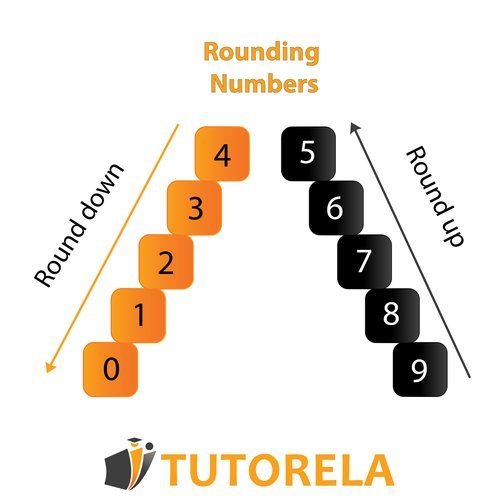When we are asked to round a number, we are actually asked to change it to the nearest whole and round number.
Rounding Numbers to 10,000 Practice Problems & Worksheets
Master rounding numbers to tens, hundreds, and thousands up to 10,000 with step-by-step practice problems, examples, and instant feedback for grades 3-5.
- Round 3-digit and 4-digit numbers to the nearest ten using the ones digit
- Round numbers to the nearest hundred by examining the tens digit
- Apply the rule: round up if digit is 5 or greater, down if less than 5
- Practice with numbers like 347, 283, and 2,849 to build confidence
- Use the tilde symbol (∼) to show rounded number relationships
- Distinguish between rounding to tens versus hundreds in multi-step problems
Understanding Rounding Numbers up to 10,000
Rounding Numbers
Rounding to tens
If the ones digit is or higher, we round up to the nearest tens, to the closest larger round number.
If the ones digit is less than , we round down to the nearest tens to the closest smaller round number.
Rounding to hundreds
If the tens digit is or higher, we round up to the nearest hundred.
If the tens digit is less than , we round down to the nearest hundred.

Practice Rounding Numbers up to 10,000
\( 870\approx\text{ ?} \)
Examples with solutions for Rounding Numbers up to 10,000
To solve this problem, we'll follow these steps:
- Step 1: Identify the last digit of the number, which is the ones digit.
- Step 2: Apply the rounding rule for the nearest ten based on the ones digit.
- Step 3: Use the rules to determine the correct rounded number.
Let's proceed through these steps:
Step 1: The number given is . Here, the ones digit is .
Step 2: When rounding to the nearest ten, we consider the rule: if the ones digit is less than , round down; if it is or more, round up.
Step 3: Since the ones digit is , which is less than , we round down. Therefore, we decrease to the nearest ten, which is .
Therefore, the solution to the problem is .
Answer:
To solve this problem, we'll follow these steps:
- Step 1: Identify the tens and units digits of the number 68.
- Step 2: Use rounding rules to determine if we round up or down.
- Step 3: Replace the units digit appropriately to find the rounded number.
Now, let's work through each step:
Step 1: The tens digit of 68 is 6, and the units digit is 8.
Step 2: Since the units digit (8) is 5 or greater, we round up the number 68.
Step 3: After rounding up, we replace the units digit with 0, resulting in the rounded number 70.
Therefore, the solution to the problem is .
Answer:
To solve this problem, we will round the number 52 to the nearest 10. Here's the step-by-step explanation:
- Step 1: Identify the ones digit of 52, which is 2.
- Step 2: Apply the rounding rule: if the ones digit is less than 5, round down; if it is 5 or more, round up.
- Step 3: Since the ones digit of 52 is 2, which is less than 5, we will round down to the nearest multiple of 10.
- Step 4: The nearest multiple of 10 below 52 is 50.
Therefore, when 52 is rounded to the nearest 10, it becomes .
Answer:
To round the number 1367 to the nearest hundred, we carry out the following steps:
- Step 1: Identify the digit in the tens place, which is '6' for 1367.
- Step 2: Apply the rounding rule where if the tens digit is 5 or greater, round up.
- Step 3: Since the tens digit is 6, we round up.
- Step 4: Replace the tens and units digits with zero.
- This results in rounding 1367 to 1400.
Thus, when rounding 1367 to the nearest hundred, we get .
Answer:
To solve this problem, we'll follow these steps:
- Step 1: Identify the tens and units digits in 465.
- Step 2: Apply the rounding rule for the nearest ten.
- Step 3: Determine the rounded value based on the rule.
Now, let's work through each step:
Step 1: The number 465 has 6 in the tens place and 5 in the units place.
Step 2: To round to the nearest ten, we look at the units digit (5). According to rounding rules, if the digit is 5 or more, we round up.
Step 3: Since the units digit of 465 is 5, we round 460 up to 470.
Therefore, the rounded value of 465 to the nearest ten is .
Answer: